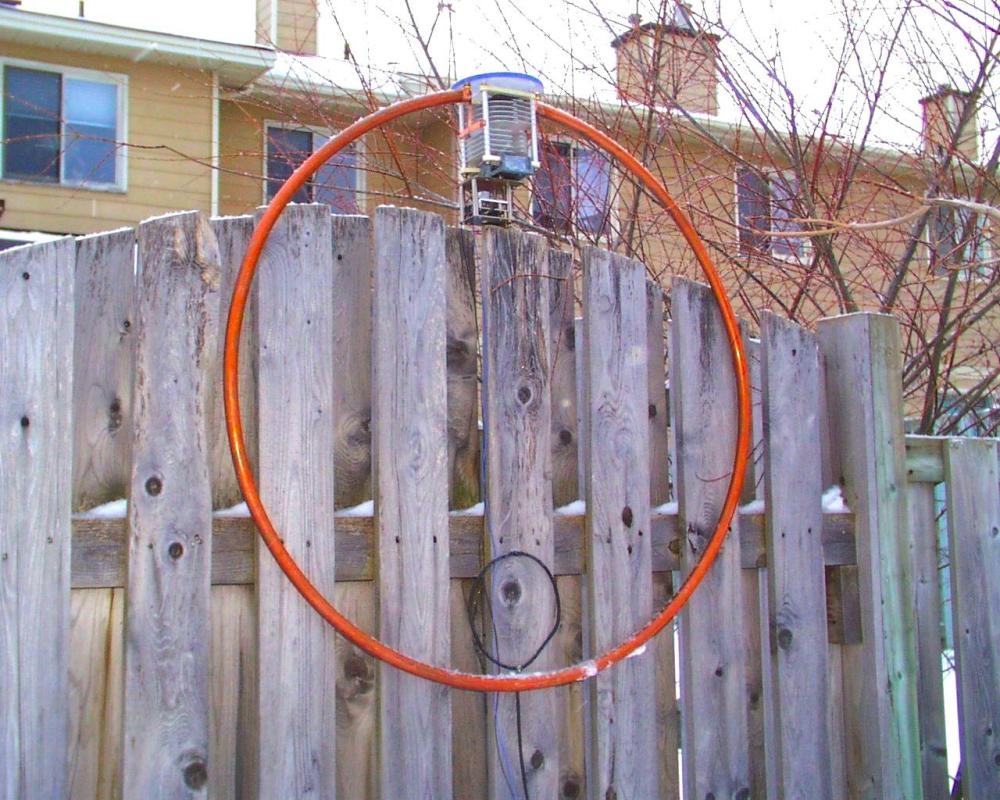
The antenna is currently under construction

VE3ABX protype loop antenna hanging off a fence
The word "efficient" may mean different things to different areas of ham radio, and involve different parameters even between receive and transmit modes.
This is especially true for large city dwellers, boxed into a small backyard or living in a condo or rented apartment surrendered by thousands of noise sources. An antenna farm or even a decent dipole antenna is often out of question. When faced with such a problem many hams move up to VHF where they can get away with small or very small antennas, some simply give up.
Others come up with, often ingenues, creations designed to bit the odds. Some of them work, some don't, (and anything in between). Most often though such designs are very customary in nature and as such tend to be rather difficult or impossible to duplicate out of their native environment for the simple reason, that their environment is typically a part of the antenna itself.
I found myself to be in the same situation, limited by both, administrative, and lot size restrictions. I have installed several smaller horizontally polarized antennas in the attic. They work quite well but are obviously limited to higher HF bands.
Some time ago I erected the 20 feet high vertical monopol antenna backed up by a number of random length radials as counterpoise. With a use of a very low loss hardline and ATU equipped rig this arrangement works quite well on 10 and 14MHz (and 7MHz to a degree) in transmit.
Its low angle of radiation allowed me to make hundreds of DX contacts in a year and a half. The physics behind such a good transmit characteristic of the antenna are a mixed blessing however. The vertically polarized electromagnetic radiation from thousands of noise sources in the city propagates much farther then its horizontally polarized counterpart. Most of the horizontally polarized incidental noise radiators are electrically rather close to ground and have high take-off angle. This combined with the fact that horizontally polarized waves are greatly attenuated by ground makes the vertically polarized noise the predominant one.
And it shows up. The noise level occasionally reaches S6 to S7 at 2.7kHz bandwidth.
Another, closely related problem I've been facing is crossmodulation caused by in-band strong signals. These signals are strong, but along they're not strong enough to have caused intermodulation problems in the rig I'm using (TS-850S). But like I mentioned my receiver is "bombarded" with noise up to S7 when 2.7kHz bandwidth is selected. The TS-850S receiver's input bandwidth is roughly 500kHz. Well, this means that even without any signals the receiver is loaded with S7 + 13dB (easily S9) worth of noise! I bet it doesn't take a lot to get to overload level from there.
This forced me to have a closer look at alternatives.
I have already been working on small, broadband, shielded and horizontally polarized loop antenna for reception only. The antenna is terminated with very low impedance, high dynamic range amplifier with about 30dB-voltage gain.
While working on it I got attracted by gaining popularity Small Transmitting Loop antennas (see my links page). My medium sized backyard seemed ideal for this kind of an antenna for lack of any metal objects in nearly 20-feet radius if properly located. The antenna was assembled to a point where it could be tested.
For the tests it was hanged off a wooden fence and a feeder was coupled to it by means of a small loop. The small loop was made from a common RG-223 cable. Center conductor makes the actual loop, which is shielded by the outer braid. The braid is cut in the top portion of the loop to prevent short circuit. The bottom portion of the loop is at about 4 feet up.
Does it work? You bet. It does. Some initial tests show that the antenna works. In a couple of days I made a number of DX contacts (LU, KL7, JA, YU, I) essentially proving that it does work.
Does it work better then other antennas? Well, the answer is not so simple. And the best answer is "it depends". A have put together a number of RF relays and switch antennas to get best results and the newly added loop antenna widens my choice. It does however substantially reduce the annoying intermodulation problem. The results, at least in terms of the tuning range and bandwidth quite closely track the theoretical results of calculations made with DOS based program rjeloop1.exe here or here that I used to design the loop. The point has been proven and I plan to go ahead with the project and complete the loop antenna. A detailed description will follow when ready.


Variable capacitor with geared DC motor
Back to my home page
Janusz Lokaj, VE3ABX. Updated May.23, 2003
